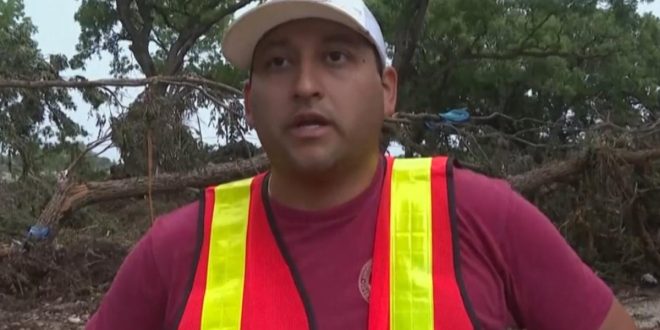Texans are known for their resilience, and that spirit has been tested once again as communities across the state grapple with the aftermath of devastating floods. From rising waters that swallowed homes whole to the heartbreaking loss of loved ones, the recent floods have left an indelible mark on the lives of countless individuals and families. But amidst the despair, stories of courage, compassion, and unwavering hope are emerging, painting a picture of a community determined to rebuild and heal.
The Fury of the Floodwaters
It’s hard to imagine unless you’ve seen it yourself, but the power of these floods was just immense. The sheer volume of water surging through neighborhoods, turning familiar streets into raging rivers… I mean, it’s the kind of thing you see in movies, not in your own backyard, right? But that’s exactly what happened, and the impact has been devastating. We’re talking homes ripped from their foundations, roads completely washed away – the kind of damage that just stops you in your tracks.
Impact on Homes and Infrastructure
The statistics paint a grim picture: hundreds of homes destroyed, thousands more damaged. Infrastructure, from bridges to power lines, has been severely compromised. You can’t even begin to think about recovery until you take stock of just how widespread the damage actually is. It’s not just about replacing things, it’s about rebuilding entire communities. And, honestly, it’s a daunting task. I think a lot of people are still in shock, trying to figure out where to even begin.
First-Hand Accounts of Evacuation and Rescue
Hearing the stories from those who were there… it’s just harrowing. Families forced to climb onto rooftops, waiting for rescue. Neighbors wading through chest-deep water to help each other. The bravery and quick thinking are amazing, but it’s heartbreaking to hear the fear in their voices. Did you hear about Mrs. Rodriguez and her grandkids being stuck on the roof for 8 hours? Unbelievable. Those kinds of stories just stick with you, you know?
Remembering Those Lost
In the wake of such widespread devastation, it’s important that you take a moment to remember those who were lost. These were members of our communities, people with families, friends, and lives that were tragically cut short. It’s a time for mourning, reflection, and coming together to support those who are grieving.
Memorial Services and Community Gatherings
Across the state, communities are holding memorial services and gatherings to honor the victims. These events provide a space for people to share their grief, offer condolences, and find solace in collective remembrance. It’s a chance to say goodbye, but also to celebrate the lives of those we’ve lost and to remember them for the contributions they made to our community. I’m thinking of attending the one in Austin next week; it feels important to show support.
Tributes to the Victims
From online memorial pages to makeshift shrines along the flooded streets, tributes to the victims are popping up everywhere. People are sharing stories, photos, and memories, creating a patchwork of remembrance that honors the lives of those who were taken too soon. It’s a reminder that even in the face of tragedy, the human spirit endures, and that love and memory can transcend even the most devastating loss. Makes you wanna hug your loved ones a little tighter, doesn’t it?
Acts of Courage and Compassion
Amidst the chaos and destruction, stories of incredible courage and compassion have emerged. These are the stories that remind you of the fundamental goodness in people, the willingness to risk everything to help a neighbor, a stranger. It’s the kind of stuff that gives you hope, even when things look really, really bleak.
Heroic Rescues by First Responders
You’ve gotta hand it to the first responders – police, firefighters, paramedics – they’ve been working around the clock, risking their own lives to rescue those stranded by the floodwaters. From wading through treacherous currents to piloting boats through flooded streets, their bravery has been nothing short of heroic. I saw a clip of a firefighter carrying a baby to safety – talk about a powerful image. Seriously, these people are amazing.
Neighbors Helping Neighbors: The Spirit of Texas
And it’s not just the professionals; ordinary people have been stepping up to help each other in extraordinary ways. People opening their homes to those who have been displaced, volunteers organizing food and clothing drives, neighbors helping neighbors muck out flooded houses – it’s a testament to the enduring spirit of community that defines Texas. Remember that saying, “Texas Forever”? It’s times like these when you really see what it means.
The Long Road to Recovery
Okay, so the immediate crisis is over, but the real work is just beginning. The recovery process is going to be long and arduous, requiring a coordinated effort from government agencies, non-profit organizations, and individual volunteers. It’s going to take time, money, and a whole lot of patience. But, hey, Texans are nothing if not resilient, right?
Assessing the Damage and Planning for Rebuilding
The first step is assessing the extent of the damage and developing a comprehensive rebuilding plan. This involves everything from inspecting homes and infrastructure to coordinating debris removal and securing funding for repairs. It’s a massive undertaking, and it’s going to require careful planning and collaboration to ensure that resources are allocated effectively and that the rebuilding process is fair and equitable. Makes you wonder where all that money is gonna come from, though, doesn’t it?
Resources and Support for Flood Victims
Fortunately, there are numerous resources available to support flood victims, from government assistance programs to charitable organizations providing food, shelter, and counseling services. It’s important for those affected by the floods to reach out and access these resources, and for those who are able to offer assistance to do so. Every little bit helps, whether it’s donating money, volunteering time, or simply offering a listening ear.
Looking Towards the Future: Lessons Learned
As the floodwaters recede and the rebuilding process begins, it’s important to take stock of the lessons learned from this disaster. What can we do to better protect our communities from future floods? How can we improve our preparedness and response efforts? These are questions that need to be addressed if we’re going to build a more resilient Texas.
Improving Flood Prevention and Preparedness
Investing in flood prevention infrastructure, such as levees and drainage systems, is crucial. But so is improving our preparedness efforts, from developing early warning systems to educating residents about flood safety. It’s about being proactive, not reactive, and taking steps to mitigate the risk of future disasters. I’ve heard some people talking about better zoning laws. Maybe that’s part of the answer?
The Importance of Community Resilience
Ultimately, the most important factor in recovering from a disaster is community resilience – the ability of a community to bounce back from adversity. This requires strong social connections, a sense of shared responsibility, and a willingness to work together to overcome challenges. And if there’s one thing Texans have, it’s a strong sense of community. I think that’s what’s gonna get us through this. Well, that and maybe a whole lot of BBQ.
You know, seeing the way Texans have come together after these floods just warms your heart, doesn’t it? It’s a reminder that even in the face of unimaginable loss, hope and resilience can prevail. Let’s all keep supporting each other, and maybe even think about what we can do personally to help our communities be better prepared for whatever Mother Nature throws our way.
 Cloudabouts
Cloudabouts




